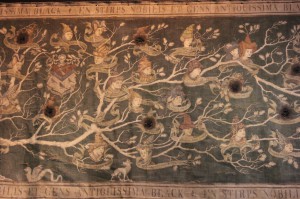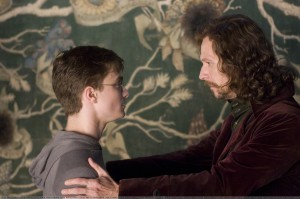I’ll be blunt: J.K. Rowling is my favorite author. I’ve read (and reread) all of her books, watched her interviews (including an episode of Who Do You Think You Are?), and I follow her on Twitter and Facebook. She has entertained me for countless hours, allowing me to explore my imagination well beyond the socially acceptable limits for those in their adult years. I am always looking forward to the newest material from the mind of Ms. Rowling.
And while I love her creativity and passion for writing, I am often most impressed with her dedication to the authenticity of the story (even when it is a story about witches and wizards).
For example, when J.K. Rowling created her magical world, she did not limit character development to Harry Potter and his immediate friends and family. She thought about Harry Potter’s parents, grandparents, and his distant ancestors (including patriarch Salazar Slytherin). She thought about the relationships between these family members: How did they interact? Whom did they marry? What were the names of their children? How did the actions/characteristics of these individuals affect the life of Harry Potter? And she did this not only for the ancestors of Harry Potter, but also for the ancestors of Sirius Black (Harry Potter’s godfather) and Ron Weasley (Harry’s best friend).
In fact, during the filming of the fifth Harry Potter film, Order of the Phoenix, producer David Heyman contacted Rowling when a wall-sized family tree tapestry was required for a scene between Daniel Radcliffe (Harry Potter) and Gary Oldman (Sirius Black). Because all of the specifics of the Black family tree were not included in the book, Mr. Heyman hoped that Rowling would be able to provide a few additional names for aesthetic purposes: “In the book there are only a handful of names, but when you bring it to film, you actually have to visualize it, so I called Jo, and said ‘Jo, we need some more information, can you help us?’ Fifty minutes later she faxed down the Black family tree, which went back four or five generations and had seventy-five to a hundred names.”[1] From this, set designers created a full length tapestry showing some of the Black family names.
 Yet her dedication to the Potter, Black, and Weasley genealogies might lead one to think: Why would J.K. Rowling waste her time creating, organizing, and developing characters that would never be included in the seven novels or the eight movies in the series?
Yet her dedication to the Potter, Black, and Weasley genealogies might lead one to think: Why would J.K. Rowling waste her time creating, organizing, and developing characters that would never be included in the seven novels or the eight movies in the series?
First, for continuity: For epic novels, like Harry Potter or The Lord of the Rings, organized family trees help the author (and the reader) to follow the story line. Writing teachers even suggest using genealogical software when developing a novel, as it may deter mistakes in identity, age, or relationships.
But more importantly, for character development: Authors often develop their fictional characters through the relationships that they share with other people, whether parents, friends, siblings, or significant others. Yet J.K. Rowling takes the connection between her characters beyond the confines of the immediate family, and expands them to include ancestors from previous generations. For example, the tensions between the Weasley and Malfoy families (commonly seen throughout the seven Harry Potter books), began generations before the birth of Ron Weasley and Draco Malfoy.
So what does this have to do with genealogy? Well … just as J.K. Rowling created Harry Potter’s extended family in an effort to accurately tell his story, so too your own genealogical research demands similar treatment. Where and when were you born? Who were you named after? Do you have several veterans in your family? What nationality/ethnic group do you identify with? What is your religion or family tradition? For most, the influence of your family (both immediate and distant) will play a significant role in the way you answered the above questions. Therefore, if you wish to tell your story in the most accurate way, it is important to research and document those who have come before you. This will help to place you into the larger narrative of your own family history, and possibly explain some of your allegiances as well.
Note
[1] David Heyman, interview, special features, Harry Potter and the Order of the Phoenix. DVD. Warner Bros. Pictures, 2007.
Share this:
About Lindsay Fulton
Lindsay Fulton joined the Society in 2012, first a member of the Research Services team, and then a Genealogist in the Library. She has been the Director of Research Services since 2016. In addition to helping constituents with their research, Lindsay has also authored a Portable Genealogists on the topics of Applying to Lineage Societies, the United States Federal Census, 1790-1840 and the United States Federal Census, 1850-1940. She is a frequent contributor to the NEHGS blog, Vita-Brevis, and has appeared as a guest on the Extreme Genes radio program. Before, NEHGS, Lindsay worked at the National Archives and Records Administration in Waltham, Massachusetts, where she designed and implemented an original curriculum program exploring the Chinese Exclusion Era for elementary school students. She holds a B.A. from Merrimack College and M.A. from the University of Massachusetts-Boston.View all posts by Lindsay Fulton →
